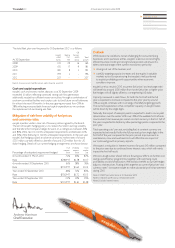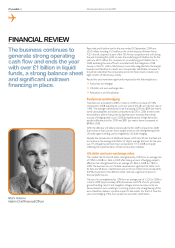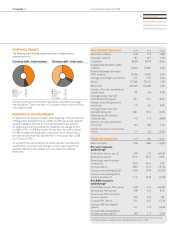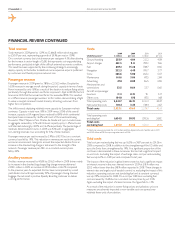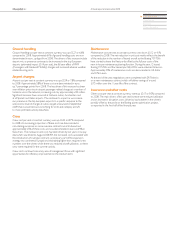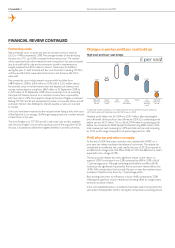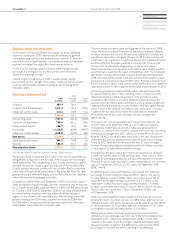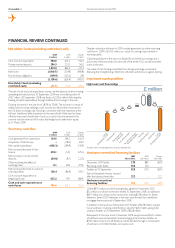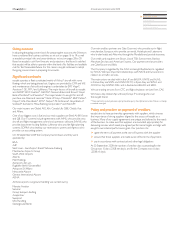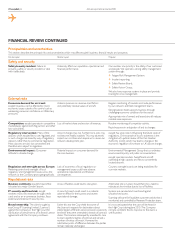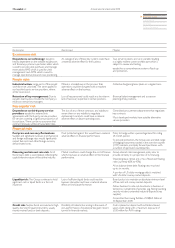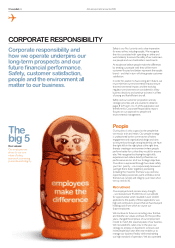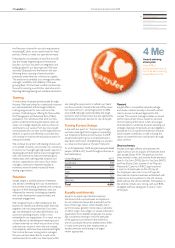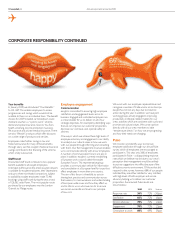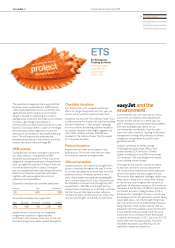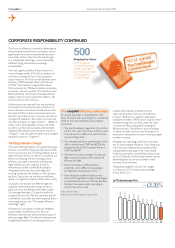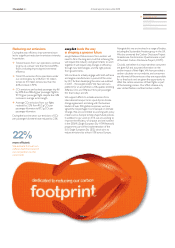EasyJet 2009 Annual Report Download - page 31
Download and view the complete annual report
Please find page 31 of the 2009 EasyJet annual report below. You can navigate through the pages in the report by either clicking on the pages listed below, or by using the keyword search tool below to find specific information within the annual report.
Annual report and accounts 200929 easyJet plc
q
Overview
Business review
Governance
Accounts
Other information
Risk description Potential impact Mitigation
E-commerce risk
Dependence on technology: easyJet is
heavily dependent on the website easyJet.com
and three key systems in particular: eRes, which
is used to process seat purchases and manage
reservations; RMS which is used for yield
management; and AIMS, which is used to
manage operational data and crew positioning.
An outage of any of these key systems could have
a material adverse effect for the business.
Two server locations are run in parallel resulting
in a highly resilient system architecture which is
subject to review and testing.
easyJet has a comprehensive system of back-up
and protection.
People risks
Industrial action: Large parts of the easyJet
workforce are unionised. The same applies to
our key third-party service providers, where
similar issues exist.
If there is a breakdown in this process, then
operations could be disrupted with a resultant
adverse effect on the business.
Collective bargaining takes place on a regular basis.
Retention of key management: Due to
easyJet’s lean business model, the Company is
reliant on certain key managers.
Loss of key personnel could result in a short-term
lack of necessary expertise in certain positions.
Bi-annual talent management and succession
planning of key positions.
Key supplier risk
Dependence on third-party service
providers: easyJet has entered into
agreements with third-party service providers
for services covering a signicant proportion of
its cost base. There can be no assurance that
contract renewals will be at favourable rates.
The loss of any of these contracts, any inability to
renew them or any inability to negotiate
replacement contracts could have a material
adverse effect on future operating costs.
Centralised procurement department that negotiates
key contracts.
Most developed markets have suitable alternative
service providers.
Financial risks
Fuel price and currency uctuations:
Sudden and signicant increases in jet fuel price
and foreign exchange rates would signicantly
impact fuel costs and other foreign currency
denominated costs.
If not protected against, this would have a material
adverse effect on nancial performance.
Policy to hedge within a percentage band for rolling
24 month period.
To provide protection, the Group uses a limited range
of hedging instruments traded in the over the counter
(OTC) markets, principally forward purchases, with
a number of approved counterparties.
Financing and interest rate risk: All of
the Group’s debt is asset related, reecting the
capital intensive nature of the airline industry.
Market conditions could change the cost of nance
which may have an adverse effect on the nancial
performance.
Group interest rate management policy aims to
provide certainty in a proportion of its nancing.
Operating lease rentals are a mix of xed and oating
rates (currently 60% to 40%).
All on balance sheet debt oating rate, re-priced
up to six months.
A portion of US dollar mortgage debt is matched
with US dollar money market deposits.
Liquidity risk: The Group continues to hold
signicant cash or liquid funds as a form of
insurance.
Lack of sufcient liquid funds could result in
business disruption and have a material adverse
effect on nancial performance.
Board policy is to maintain an absolute minimum level
of free cash and money market deposits.
Allows business to ride out downturns in business or
temporary curtailment of activities (e.g. eet grounding,
security incident, extended industrial dispute at key
supplier).
Committed borrowing facilities of US$0.5 billion at
30 September 2009.
Credit risk: Surplus funds are invested in high
quality short-term liquid instruments, usually
money market funds or bank deposits.
Possibility of material loss arising in the event of
non-performance of counterparties given recent
turmoil in nancial markets.
Cash is placed on deposit with institutions based
upon credit rating with a maximum exposure of
£100 million for AAA ratings.


